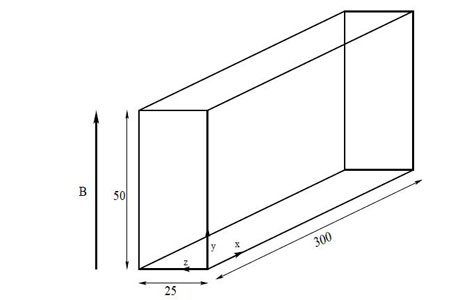MODULES
Study of 3D Fully Developed Steady Laminar MHD Flow
Problem Definition
Here the flow is flowing in a rectangular duct of cross section 25 mm×50 mm and of length 300 mm. the fluid considered for numerical simulation is NaK and the uniform applied transverse magnetic field is parallel to the longer side of cross section (i.e. 50 mm side). Here fluid flow is taken in X direction and magnetic field is taken in Y direction. The walls of the duct are considered as perfectly insulating. The Geometry is shown in fig. 1.6. The following parameters are used for simulation.
• Length of the channel = 300 mm
• Width of the channel = 50 mm
• Thickness of channel = 25 mm
• Grid points are 90 × 50 × 40.
• Density of NaK = 857.6 kg/mm3
• Electric Conductivity of NaK = 2.691×106 S/m
• Dynamic Viscosity(μ) of NaK = 7.131×10−4 Pa.s

Figure 1.6: Schematic of computational geometry. All dimensions are in mm unit
Boundary condition given to solve this problem is as flows:

The numerical velocity profile across the side walls in dimensionless form obtained from simulation has been compared with corresponding analytical solution and is shown in fig. 1.7 and there is a very good match of the profile with analytical solution.

Figure 1.7: Comparison of velocity profile at outlet for Ha=500 across side layer in a rectangular duct (walls are perfectly insulated).
[1] Hartmann J. and Lazarus F. (1937) ‘Experimental investigations on the flow of mercury in a homogeneous magnetic field’, Mathematisk-fysiske Meddlelser, vol. XV(7).
[2] Chang C. and Lundgren T. (1961) ‘Duct flow in magnetohydrodynamics’,
Zeitschrift fr angewandte Mathematik und Physik, vol. XII, pp. 100–114.
[3] Hughes M., Pericleous K.A., and Cross M. ‘The CFD analysis of simple
parabolic and elliptic MHD flows’, Centre for Numerical Modelling and ProcessAnalysis, University of Greenwich, London, UK.


